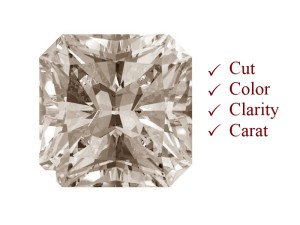
The Characteristics of the Radiant Cut
The radiant diamond cut has a rectangular or square shape, and its corners are truncated.
Its outline looks very similar to that of the emerald cut, but unlike it, the radiant cut is actually a brilliant cut.
This means that the facets of radiant diamonds are arranged so as to maximize brilliance.
(The radiant cut is also referred to as a “mixed cut,” as it also has characteristics of step cuts, such as the emerald cut.)
Evaluating the Cut Quality of Radiant Diamonds
The quality guidelines for the radiant cut are not as detailed and precise as those for the round cut, but here are some recommended ranges for the most important proportions:
Table ratio (the length of the top as a percentage of the girdle) should ideally be around 60-70%.
Total depth (the distance from the top of the stone to its bottom) should be 60-65% of the girdle.
Girdle thickness should be very thin to slightly thick; extremely thick or extremely thin girdles are undesirable.
The culet (the facet at the stone’s bottom) should be small or nonexistent. Medium to big culets may be visible through the top of the stone.
The symmetry and polish of the stone are secondary in terms of importance, but you should avoid radiant diamonds that are graded Poor on these characteristics.
Asymmetrical facets and a poorly polished surface can impair the look and even the brilliance of a stone.
Choosing a Color Grade for a Radiant Diamond
The color of radiant cuts is graded on the same scale as that of all other diamonds, but you should be aware that radiants tend to show more color than round cuts.
If your radiant diamond is going to be set in a white setting, such as one made of platinum or white gold, then it is recommended that the stone’s color be in the F-G-H grading range.
For yellow gold settings, you can go lower, as any yellowish tints in the diamond will be absorbed by the setting’s color – you can get an I or J color, and it will still look reasonably colorless when set.
Selecting Clarity for Radiant-Cut Diamonds
Selecting a clarity grade for a radiant-cut diamond boils down to finding a stone that doesn’t have visible flaws.
The good thing about radiant cuts is that because of their brilliance, inclusions tend to not be as visible as in less brilliant cuts (e.g., step cuts).
While it is easy to go for the highest clarity grades (i.e., FL or IF clarity), this is quite an expensive choice. There are lower-clarity radiant diamonds that do not have visible inclusions but are cheaper.
If you go as low as VS2 or SI1 clarity, or even SI2 clarity, you may find an eye-clean stone (i.e., one whose flaws cannot be seen from a normal viewing distance) at a pretty good price.
Radiant Cuts and Carats
When choosing the carat of your radiant-cut stone, you should keep in mind that the bigger a diamond, the more visible its imperfections such as inclusions or yellow tints.
Therefore, if you are ready to spend additional money for a radiant diamond of higher carat weight, don’t forget that you may also need to pay more money for better color and clarity.
Where to Buy Diamond Jewelry?
We recommend James Allen (read review) because you can see a 360-degree video for any diamond before buying it.
Blue Nile is another reputable diamond retailer we recommend.














